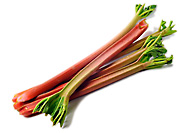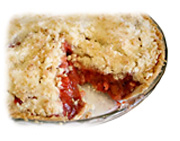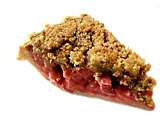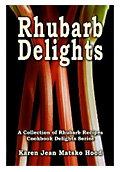|
|
 Rhubarb: An Ancient Laxative Rhubarb: An Ancient Laxative
by Marjorie Dorfman
Where does rhubarb come from? How did it get its name and how come most of us think of it as a fruit instead of a vegetable? These and other stinging questions will be answered below.
|
The earliest recorded use of rhubarb dates back more than 5,000 years to Imperial China where the fried roots of this vegetable were considered a powerful laxative and astringent. The ancient Greeks and Romans also dried rhubarb roots for medicinal purposes as documented by the famous Greek pharmacologist, Discorides.
The word, rhubarb, which botanically is known as Rheum rhaburbarum, has both Greek and Roman origins. It is derived from the Greek word, Rha for the Volga River and the Latin word, barbarum, which refers to that region of the Rha River inhabited by non-Romans (barbarians).
 Rhubarb is considered a fruit because of its heavy use in desserts, but botanically, it is an ornamental vegetable. The confusion lies in the fact that it is usually prepared and eaten much like a fruit. Compounding this conundrum is the 1947 court decision that ruled rhubarb as a fruit in the United States for the purposes of regulations and duties, which resulted in a decrease in taxes. Rhubarb is considered a fruit because of its heavy use in desserts, but botanically, it is an ornamental vegetable. The confusion lies in the fact that it is usually prepared and eaten much like a fruit. Compounding this conundrum is the 1947 court decision that ruled rhubarb as a fruit in the United States for the purposes of regulations and duties, which resulted in a decrease in taxes.
In written accounts chronicling his travels, Marco Polo wrote profusely about the powers of Chinese rhubarb. During his lifetime, (1254-1324) Venice was a vital and bustling trade mecca, and rhubarb was widely imported and utilized in European pharmacology, especially at the University of Salerno. The very first documented planting of rhubarb in Italy occurred in 1608 and by 1628, it had spread throughout Europe.
Rhubarb was known as a cathartic centuries before Milk of Magnesia and others of its ilk came to be. For thousands of years, rhubarb was the most popular laxative and is used even today because the roots, when dried, not only work well, the effects are also painless and short-lived. The application of cathartics played a much more prominent role in ancient medicine than they do today.
 It was the inimitable Ben Franklin who was responsible for transporting rhubarb seeds to the North American eastern coast in 1772. The red stalks weren't popular for at least a good thirty years after that when they became popular ingredients for pie. In the late 1800s, the Russians brought rhubarb to Alaska's shores as a treatment for scurvy. By the 1900s, rhubarb, which was nicknamed “pie plant,” was immensely popular in the New England states where it was an essential component of pastry, pie-fillings and homemade wine. It was the inimitable Ben Franklin who was responsible for transporting rhubarb seeds to the North American eastern coast in 1772. The red stalks weren't popular for at least a good thirty years after that when they became popular ingredients for pie. In the late 1800s, the Russians brought rhubarb to Alaska's shores as a treatment for scurvy. By the 1900s, rhubarb, which was nicknamed “pie plant,” was immensely popular in the New England states where it was an essential component of pastry, pie-fillings and homemade wine.
The Renaissance and Industrial Age marked times when researchers were trying to understand why rhubarb was so effective medicinally as a cathartic and astringent. Scientists also tried to unsuccessfully develop tests and procedures to improve the quality of rhubarb. Eventually, scientists recognized that anthraquinones, such as emodin and rhein, explain the power of rhubarb as a laxative. These organic compounds are found in several plants and they are known to exist in both the roots and the stalks.
In the mid 19th century, the modern market for culinary rhubarb was formally created by Joseph Myatt, a nurseryman from London, England, who developed a recipe for tarts using rhubarb and had the guts to convince his friends and neighbors to try it, combining the bitter flavor with something sweet, like strawberries (which he also produced).
The result was even better than expected, as the dessert was a welcome change after a long winter of preserves and meat. As it became more and more popular, new preserving techniques were developed such as canning, drying and more recently, freezing.
 Rhubarb species are divided into two very broad categories; one called Victoria and the other red rhubarb. The former usually has stalks that range from pure green to light red while the inside is always green. These varieties are larger, stronger and relatively disease-resistant unlike their red rhubarb counterparts. This group has deep red stalks both inside and on the exterior, and these plants are smaller and more susceptible to disease. Rhubarb species are divided into two very broad categories; one called Victoria and the other red rhubarb. The former usually has stalks that range from pure green to light red while the inside is always green. These varieties are larger, stronger and relatively disease-resistant unlike their red rhubarb counterparts. This group has deep red stalks both inside and on the exterior, and these plants are smaller and more susceptible to disease.
Since World War II, the production of rhubarb has continued at a steady pace, but not to levels equal to the days before the war. Throughout the United States, there are about 1300 acres devoted to rhubarb production, located within the boundaries of California, Oregon, Washington State (60%) and Colorado.
To this day, dried rhubarb is sold as a laxative. The original Chinese variety remains the most effective of them all.
So purge ye as you will… and enjoy the sweet taste of rhubarb pie in the process.
Did you know . . .
 Here's another book we couldn't resist. So many great things to try! Here's another book we couldn't resist. So many great things to try!
The Joy of Rhubarb: The Versatile Summer Delight
by Theresa Millang
This book will show even the most novice kitchen cook just what can be done with rhubarb in more than 200 recipes. From a classic Apple-Rhubarb Crunch; to Rhubarb Loaf Cake (served warm and topped off with sweetened whipped cream), to Rice Pudding with Rhubarb Sauce; The Joy Of Rhubarb provides an impressive diversity of recipes for one of the most versatile offerings of the family garden.
|
|
|
|
 |
|
|
|
|
Don't miss this excellent book:
Rhubarb Delights Cookbook: A Collection of Rhubarb Recipes
by Karen Jean Matsko Hood

Rhubarb is an all-time favorite vegetable that once was used for medicinal purposes, but has always tasted delicious in Mom's homemade pie. In this cookbook, you'll find more than just pie recipes to spark your imagination in cooking with rhubarb. Not only a cookbook, but a wealth of information about rhubarb: it includes fascinating facts, folklore, history of rhubarb, nutrition and health, types of rhubarb, and original poetry.
|

Click for a printer friendly version of this article.
|
|